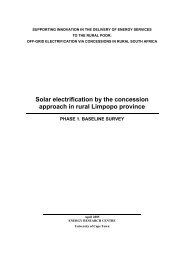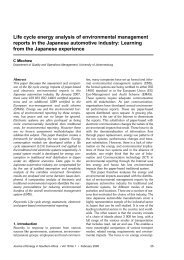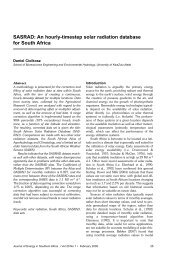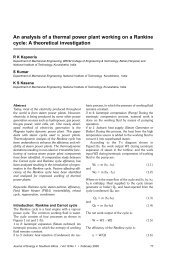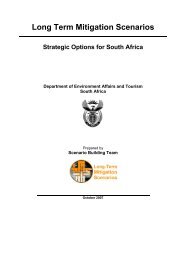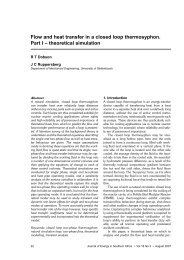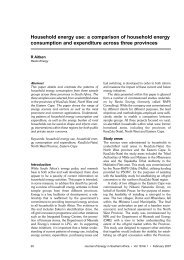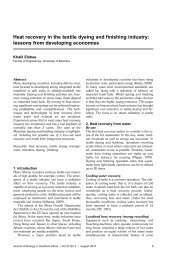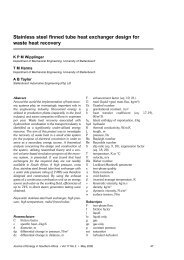Climate variability, climate change and water resource strategies for ...
Climate variability, climate change and water resource strategies for ...
Climate variability, climate change and water resource strategies for ...
Create successful ePaper yourself
Turn your PDF publications into a flip-book with our unique Google optimized e-Paper software.
<strong>Climate</strong> <strong>variability</strong>, <strong>climate</strong> <strong>change</strong> <strong>and</strong> <strong>water</strong> <strong>resource</strong> <strong>strategies</strong> <strong>for</strong> small municipalities<br />
6. Impact of <strong>climate</strong> <strong>change</strong> on <strong>water</strong> <strong>resource</strong>s,<br />
specifically ground<strong>water</strong><br />
The impact of <strong>climate</strong> <strong>change</strong> on <strong>water</strong> <strong>resource</strong>s, including ground<strong>water</strong>, acts through a<br />
modification of the <strong>water</strong> balance, ranging from the micro to the macro-scale. This included factors<br />
such as surface conditions, the soil column, aquifers <strong>and</strong> catchments (Braune 1996).<br />
In a recent review of the current hydroclimatic “l<strong>and</strong>scape” in southern Africa, Schultze motivates<br />
that there is a highly variable <strong>and</strong> highly sensitive natural hydrological system over southern Africa.<br />
He defended the following premises (Schulze 2005b):<br />
1. Even when considering average present climatic conditions, we already live in high risk<br />
hydroclimatic environment in southern Africa<br />
2. An already high inter-annual rainfall <strong>variability</strong> is amplified by the natural hydrological<br />
system<br />
3. Intra-annual variabilities of hydrological responses are even higher than inter-annual ones<br />
4. Different components of the hydrological system differ markedly in their responses to<br />
rainfall <strong>variability</strong><br />
5. Streamflow <strong>variability</strong> is high in individual external sub-catchments, but in a river system<br />
becomes attenuated in internal <strong>and</strong> mainstem catchments<br />
6. L<strong>and</strong> use <strong>change</strong> by intensification or extensification of biomass often increases flow<br />
<strong>variability</strong> because it <strong>change</strong>s the partitioning of rainfall into stormflow <strong>and</strong> baseflow<br />
components<br />
7. Degradation of the l<strong>and</strong>scape can amplify further any hydrological responses, especially<br />
higher order responses<br />
The South African Country Study on <strong>Climate</strong> Change found that when running GCM <strong>and</strong> ACRU<br />
models, runoff was found to be highly sensitive to <strong>change</strong>s in precipitation. Ground<strong>water</strong> recharge<br />
was found to be even more sensitive. Under one of the hotter drier GCM scenarios, decrease in<br />
runoff of up to 10% in some areas could be experienced. A decrease of this magnitude could occur<br />
in the western area of the country by as early as 2015 (Kiker 2000) (Schulze & Perks 2000).<br />
Ground<strong>water</strong> in South Africa usually occurs in secondary aquifers <strong>and</strong> normally soil cover is<br />
shallow. Recharge of the aquifer depends on its type. Some are more responsive to rainfall <strong>and</strong><br />
recharge is closely linked to higher <strong>and</strong> persistent rains. Others, such as deep aquifers, are slow to<br />
respond <strong>and</strong> require consistent rain over a period of time (Visser 2004). Studies by Kirchner have<br />
shown that be<strong>for</strong>e any recharge takes place, a rainfall <strong>and</strong> soil moisture threshold must be overcome<br />
(after Kirchener et al. 1991). The bulk of the recharge takes place in the years in which the average<br />
annual rainfall is exceeded <strong>and</strong> during periods of high rainfall intensity. It st<strong>and</strong>s to reason, then, that<br />
the areas that are dependent on ground<strong>water</strong> will be most vulnerable to decreases in rainfall <strong>and</strong>/or<br />
<strong>variability</strong>. In addition, low storage aquifers are the most vulnerable to <strong>change</strong>s <strong>and</strong> <strong>variability</strong> in<br />
recharge. This is the situation in 90% of the country (Braune 1996).<br />
There<strong>for</strong>e, when considering the impact of drought on the available ground<strong>water</strong> <strong>for</strong> a specific<br />
aquifer, it is necessary to determine the recharge regime of the aquifer. The historical recharge data<br />
plotted against <strong>climate</strong> trends <strong>for</strong> the past 50 years would provide an underst<strong>and</strong>ing of the type of<br />
rainfall needed to ensure adequate recharge. With this knowledge it will be possible to develop a<br />
management system <strong>for</strong> that specific aquifer. Continual monitoring of the aquifer against <strong>climate</strong><br />
conditions will provide some knowledge of the future potential under projected <strong>climate</strong> conditions.<br />
26




